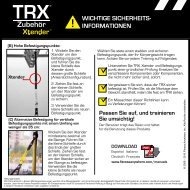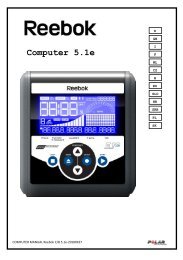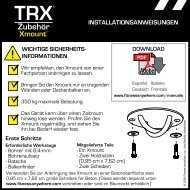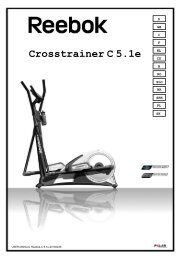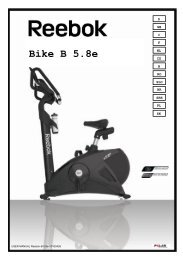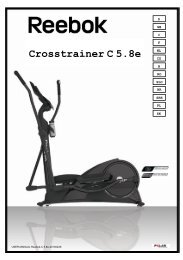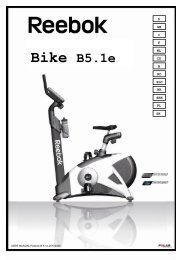by Body-Solid® - Fitness4all
by Body-Solid® - Fitness4all
by Body-Solid® - Fitness4all
You also want an ePaper? Increase the reach of your titles
YUMPU automatically turns print PDFs into web optimized ePapers that Google loves.
DETERMINE YOUR<br />
TRAINING METHOD<br />
There are three basic types of weight<br />
training methods:<br />
1. Training for muscular<br />
endurance and definition<br />
2. Training for strength<br />
3. Training for power and<br />
muscle mass<br />
You should select a training method<br />
that reflects both your present fitness<br />
level and your long term goals. You<br />
should begin carefully and with proper<br />
professional guidance. You can always<br />
move from one training method to<br />
another as you progress.<br />
If you are beginner, you should start<br />
slowly and carefully, gradually increasing<br />
the frequency and intensity of your<br />
training. Always play it safe – be realistic<br />
about your goals and your schedule.<br />
Realistic goals are safer and easier to<br />
follow.<br />
Which is the right training method<br />
for you? First, take a look at your<br />
present physique and determine your<br />
objectives. Do you want a trim, toned,<br />
well-defined body? Are you involved in<br />
a sport where speed, strength and<br />
power are most important? Maybe you<br />
want bulging muscles and a terrific<br />
V-shape torso so you look great on the<br />
beach. Once you make a decision on<br />
what the final results should be, you<br />
can set up your personal program<br />
using the proper training method to<br />
achieve your goals.<br />
Which training method is right for you?<br />
FOR MUSCULAR<br />
ENDURANCE & DEFINITION<br />
This training method incorporates<br />
achieving and maintaining a high<br />
cardiovascular (heart) rate and helps<br />
burn away excess fatty tissue. It also<br />
adds muscle definition and muscular<br />
endurance to your entire body.<br />
Exercises are most commonly<br />
performed for 15 to 20 repetitions and<br />
3 to 4 sets using a light to moderate<br />
weight. The rest period between sets<br />
should be about 30 seconds. These<br />
short rest intervals will help maintain an<br />
elevated heart rate and prevent the<br />
muscles from cooling down.<br />
DESIGNING YOUR PERSONAL ROUTINE<br />
FIRST:<br />
You need to decide which of the above training methods is best<br />
suited to accomplish your personal goals.<br />
SECOND:<br />
Study the exercise poster that came with your <strong>Body</strong>-Solid<br />
machine and select one or two exercises per body part (body<br />
parts are listed to the left of the exercise pictures). Be sure to<br />
include exercises for all body parts. If you leave out certain<br />
body parts your exercise routine and your body will not be<br />
balanced. If you are trying to increase muscle mass or<br />
increase strength to a muscle group it is alright to add extra<br />
exercises to the area you are particularly concerned about.<br />
THIRD:<br />
Coordinate your body part exercise program and your<br />
personal schedule. If you select one exercise per body part<br />
you can normally do your entire routine in the same workout.<br />
If you choose to do more than 12 exercises you may decide<br />
to divide your workout routine into upper and lower body<br />
exercises. You can split your schedule to work upper body<br />
one day and lower body the next day. Remember to rest each<br />
particular muscle group 48 hours before working it again.<br />
69<br />
FOR STRENGTH<br />
This type of training is the most<br />
popular of the three and is designed<br />
specifically for increasing strength<br />
throughout the muscle and the<br />
muscle-tendon junction. This type of<br />
training is especially important for<br />
athletes. Normally, exercises are<br />
performed using moderate to heavy<br />
weight for 8 to 12 repetitions and 2 to 3<br />
sets. The rest period between sets<br />
should be from 60 to 90 seconds. This<br />
allows a degree of muscle recovery<br />
before you hit them again.<br />
FOR POWER<br />
AND MUSCLE MASS<br />
This is the method most often used <strong>by</strong><br />
bodybuilders and is recommended<br />
only for the intermediate and<br />
advanced lifter. The weights used are<br />
heavy — this shocks the muscles and<br />
stimulates a more rapid increase in<br />
muscle size. Usually exercises are<br />
performed for 2 to 6 repetitions and<br />
3 to 4 sets using very heavy weight.<br />
The rest period between sets should<br />
be from 3 to 4 minutes. The prolonged<br />
rest periods allow ample time for<br />
recovery between sets.<br />
FOURTH:<br />
Order the exercises in your routine so you are working the<br />
large muscle groups first and the small muscle groups last.<br />
FIFTH:<br />
Keep a record! Write down the exercises, number of sets,<br />
number of reps and the amount of resistance (weight).<br />
BEGINNER’S SAMPLE WORKOUT ROUTINE<br />
WHEN TRAINING FOR DEFINITION<br />
Exercise Reps Sets<br />
Bench / Chest Press 15 to 20 3 or 4<br />
Lat Pulldown 15 to 20 3 or 4<br />
Shoulder Press 15 to 20 3 or 4<br />
Tricep Pressdown 15 to 20 3 or 4<br />
Bicep Curl 15 to 20 3 or 4<br />
Leg Press/Squat 15 to 20 3 or 4<br />
Leg Extension 15 to 20 3 or 4<br />
Leg Curl 15 to 20 3 or 4<br />
Calf Raise 15 to 20 3 or 4<br />
Ab Crunch 20 to 30 3 or 4<br />
Rest period between sets should be about 30 seconds.




